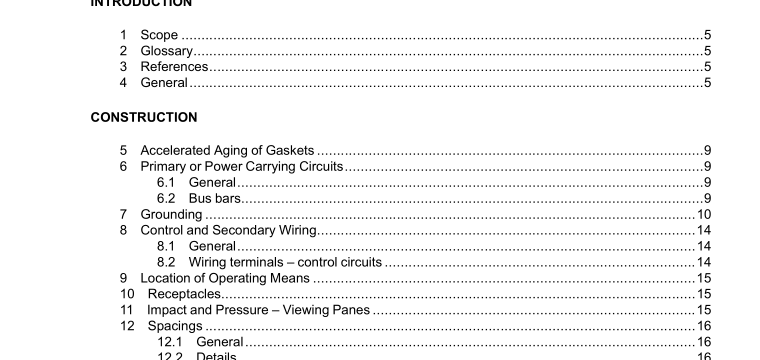UL 1558-2019 pdf download.Metal-Enclosed Low-Voltage Power Circuit Breaker Switchge.
5 Accelerated Aging of Gaskets 5.1 The requirements of this section are applicable to gaskets relied upon to enable an enclosure to meet the rain test specified in 6.2.10 of ANSI C37.20.1-2002. 5.2 A gasket of an elastomeric or thermoplastic material or a composition gasket utilizing an elastomeric material employed to make an enclosure rainproof shall comply with 5.3 and 5.4. 5.3 If an enclosure is provided with a rubber or rubber-like gasket, samples of the gasket shall be subjected to a temperature of 70 ±1°C (158 ±1.8°F) in circulating air for 168 hours. The tensile strength after the exposure shall not be less than 60 percent and the elongation shall not be less than 75 percent of the values determined with unaged samples. 5.4 A gasket of thermoplastic material, or a composition thereof, may be accepted after consideration of the effects of heat aging, distortion under conditions of use, and the means of securing the gasket to the cover or enclosure. 6 Primary or Power Carrying Circuits 6.1 General 6.1.1 The requirements of this section shall be applied in addition to those specified in 7.1.1 of ANSI C37.20.1-2002.
6.2 Bus bars 6.2.1 The bending of a bus bar shall not result in visible cracks, but roughening or slight surface crazing is acceptable. 6.2.2 A bolted joint involving aluminum bus bars shall comply with the requirements of 6.2.3 and 6.2.4, unless: a) A spring washer as described in 6.2.6 is used at one end of each bolt securing current-carrying parts together is used, or b) A locknut or a split-ring lock washer and a flat washer as described in 6.2.5 is used and each aluminum bus in the joint has a tensile yield strength of at least 20,000 psi (138 MPa). c) A flat washer, as described in 6.2.5, and aluminum bolts are used with aluminum bus bars. 6.2.3 A switchgear bus, as mentioned in 6.2.2, that employs a bolted joint construction with aluminum bus bars shall be subjected to the test described in 6.2.4. The temperature rise at the joint during the 500th cycle shall not be more than 15°C (27°F) higher than the temperature rise at the 25th cycle. Exception: Constructions described in 6.2.2 (a), (b), or(c), need not complywith this requirement. 6.2.4 The test sample is to consist of an assembly of bus bars connected together to form a series circuit. The bus bars are to be clamped together with the joint construction used in actual production. The number and size of the bus bars are to represent the maximum ampere rating and the maximum current density in which the joint construction is to be employed. This may necessitate more than one test. The length of each bus bar is to be not less than 2 ft (610 mm). The bus bar is to be connected to a power supply by any convenient means that will not affect the joint temperature.
6.2.5 The flat washer mentioned in 6.2.2 (b) and (c) shall have a nominal thickness of at least 1/6 that of the diameter of the bolt and shall have an outer diameter at least 150 percent of bolt and not less than the outer diameter of any spring washer employed. 6.2.6 A typical spring washer as mentioned in 6.2.2 is a dished washer of stainless, or hardened and tempered steel, having an outer diameter not less than 150 percent of the bolt diameter, a thickness not less than 1/8 of the bolt diameter, and nominally dished not less than 3-1/2 percent of the bolt diameter. Other configurations are acceptable if they provide equivalent spring action. 6.2.7 A construction other than described in 6.2.2 may be accepted if it is investigated and found acceptable for the particular application. 6.2.8 Unless investigated for such use, a bolted connection between two bus bars or between a bus bar and another current carrying part shall not depend on any polymeric insulation to maintain the clamping force and shall not depend on thermoplastic material in any case. 6.2.9 When bolts, nuts, and washers are provided for connecting through bus to other sections, the length of the bolts shall be such that spacings in accordance with Table 12.1 are maintained. 6.2.10 A bus bar or uninsulated live part, other than a pressure wire connector as mentioned in the Exception of 12.2.7, shall be secured so that ordinary vibration will not loosen the securing means, and shall be prevented from turning or shifting in position if any spacings less than half those indicated in Table 12.1 would result from such turning or shifting. A bus bar provided with one or more insulators that must be removed when a unit is installed shall be prevented from any turning that would result in spacings less than half those specified in Table 12.1 with all insulators in place, or that would result in spacings less than 1/8 inch (3.2 mm) for any voltage up to 250 V, or 1/4 inch (6.4 mm) for any voltage of 251 to 1000 V, with any insulators omitted.UL 1558-2019 pdf download.
UL 1558-2019 pdf download
